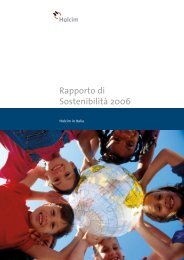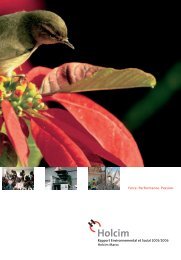Key success factors
Key success factors
Key success factors
You also want an ePaper? Increase the reach of your titles
YUMPU automatically turns print PDFs into web optimized ePapers that Google loves.
24 Value-Driven Corporate Management<br />
Innovation<br />
Holcim is stepping up the pace of innovation along<br />
the entire value chain, with research projects currently<br />
focusing on broadening the product range, reducing<br />
energy input and emissions and introducing new process<br />
technologies.<br />
Global network promoting research and development<br />
The strong consolidated Group growth of recent years<br />
has substantially expanded our research and development<br />
network. The dual product strategy launched in<br />
2006, which is based on the two resources hydraulic<br />
binders and aggregates, has led to an increase in the<br />
importance of the segments “Aggregates” and “Other<br />
Construction Materials and Services” alongside the<br />
core cement business. Research and development<br />
activities have been restructured accordingly. While<br />
the central corporate staff units focus on long-term<br />
fundamental research, the local Group companies systematically<br />
pursue demand and client-driven development.<br />
Both tiers cooperate closely. Group-wide patent<br />
management has become more important. In 2006,<br />
Holcim invested a total of around CHF 25 million in<br />
research and development.<br />
The Group is also conducting research into fundamentally<br />
new types of cement. These are intended as<br />
additions to the traditional product range, enabling<br />
Holcim to gain greater competitiveness in a dynamic<br />
environment. Another area of research is concerned<br />
with the complex nanostructures of concrete which<br />
are crucial to its properties. Working in close cooperation<br />
with technical universities in Switzerland and<br />
abroad, Holcim is attempting to influence the complex<br />
nanostructures with a specific view to improving<br />
product properties.<br />
New building materials in vogue<br />
Holcim is committed to using new cementitious<br />
binders, which are more competitive and sustainable<br />
than steel, aluminum, wood or glass. A key factor is the<br />
durability of the concrete, which is the end-product.<br />
In late 2006, Holcim introduced CEMROC® to the<br />
French and Belgian markets. This novel type of environmentally<br />
efficient cement for special applications<br />
is based mainly on blast furnace slag. In comparison<br />
with conventional concrete, concrete made with<br />
CEMROC® is more resistant to a range of chemicals<br />
and is significantly more durable. The production of<br />
CEMROC® generates around 95 percent less CO2 than<br />
traditional Portland cement. Promising applications<br />
include concrete elements prefabricated under industrial<br />
conditions, as well as bridges, dams and components<br />
for sea defenses and port facilities.<br />
Use of self-compacting concrete is on the increase.<br />
Holcim offers products of this type in several<br />
countries. In Switzerland, they are already very well<br />
established under the brand names Selfpact®<br />
and Flextremo®.<br />
At the GreenBuilt exhibition held at the end of 2006,<br />
Holcim US launched an environmentally friendly<br />
product range under the brand name Envirocore TM .<br />
Thanks to their reduced clinker content, these highquality<br />
composite cements are making an important<br />
contribution to CO2 reduction.










